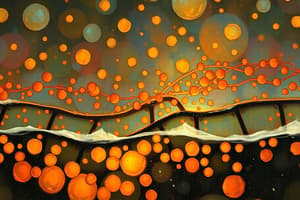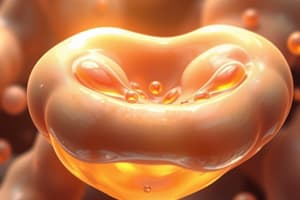Podcast
Questions and Answers
What is the primary function of lipids in cells?
What is the primary function of lipids in cells?
- Long term energy storage (correct)
- Short term energy storage
- Immediate energy release
- Protein synthesis
What type of fat is typically solid at room temperature?
What type of fat is typically solid at room temperature?
- Saturated fats (correct)
- Trans fats
- Polyunsaturated fats
- Unsaturated fats
Which of the following best describes phospholipids?
Which of the following best describes phospholipids?
- They are solid fats used for energy storage.
- They form the membranes of cells. (correct)
- They are a source of hormones.
- They are involved in muscle contraction.
What is a significant structural feature of steroids?
What is a significant structural feature of steroids?
Which nucleotide is found only in RNA?
Which nucleotide is found only in RNA?
What type of bond is characterized by the sharing of electrons between atoms?
What type of bond is characterized by the sharing of electrons between atoms?
What occurs during dehydration synthesis?
What occurs during dehydration synthesis?
Which statement accurately describes hydrogen bonds?
Which statement accurately describes hydrogen bonds?
In ionic bonding, what happens to an atom that loses electrons?
In ionic bonding, what happens to an atom that loses electrons?
What is the main purpose of hydrolysis in relation to polymers?
What is the main purpose of hydrolysis in relation to polymers?
Which of the following is not a type of carbohydrate?
Which of the following is not a type of carbohydrate?
What is the primary function of carbohydrates in organisms?
What is the primary function of carbohydrates in organisms?
Which of these is an example of a polysaccharide?
Which of these is an example of a polysaccharide?
What ratio of carbon, hydrogen, and oxygen do carbohydrates generally consist of?
What ratio of carbon, hydrogen, and oxygen do carbohydrates generally consist of?
Which carbohydrate is primarily involved in energy storage in animals?
Which carbohydrate is primarily involved in energy storage in animals?
Which of the following sugars is a disaccharide?
Which of the following sugars is a disaccharide?
Which structure do polysaccharides contribute to in plants?
Which structure do polysaccharides contribute to in plants?
Which of the following statements about monosaccharides is true?
Which of the following statements about monosaccharides is true?
What is the basic monomer unit of proteins?
What is the basic monomer unit of proteins?
Which of the following interacts to create the specific three-dimensional shape of a protein?
Which of the following interacts to create the specific three-dimensional shape of a protein?
What is the role of enzymes in chemical reactions?
What is the role of enzymes in chemical reactions?
How do enzymes specifically interact with substrates?
How do enzymes specifically interact with substrates?
What happens to a protein when it is denatured?
What happens to a protein when it is denatured?
What suffix is commonly found in enzyme names?
What suffix is commonly found in enzyme names?
What is the primary function of a chemical bond?
What is the primary function of a chemical bond?
How many different amino acids combine to form proteins?
How many different amino acids combine to form proteins?
Flashcards
Monomer
Monomer
A simple, single building block of a macromolecule.
Polymer
Polymer
A large, complex molecule made up of many monomers.
What are the four main macromolecules?
What are the four main macromolecules?
The four main macromolecules found in living organisms.
Carbohydrates
Carbohydrates
Signup and view all the flashcards
Monosaccharide
Monosaccharide
Signup and view all the flashcards
Disaccharide
Disaccharide
Signup and view all the flashcards
Polysaccharide
Polysaccharide
Signup and view all the flashcards
Glycogen
Glycogen
Signup and view all the flashcards
What are lipids used for?
What are lipids used for?
Signup and view all the flashcards
What is the basic structure of a lipid?
What is the basic structure of a lipid?
Signup and view all the flashcards
What are saturated fats?
What are saturated fats?
Signup and view all the flashcards
What are unsaturated fats?
What are unsaturated fats?
Signup and view all the flashcards
What are phospholipids?
What are phospholipids?
Signup and view all the flashcards
What are proteins?
What are proteins?
Signup and view all the flashcards
How does a protein's shape affect its job?
How does a protein's shape affect its job?
Signup and view all the flashcards
What is denaturation?
What is denaturation?
Signup and view all the flashcards
What is an enzyme?
What is an enzyme?
Signup and view all the flashcards
What is a substrate?
What is a substrate?
Signup and view all the flashcards
What is the active site of an enzyme?
What is the active site of an enzyme?
Signup and view all the flashcards
How do enzymes speed up reactions?
How do enzymes speed up reactions?
Signup and view all the flashcards
What is an enzyme pathway?
What is an enzyme pathway?
Signup and view all the flashcards
Covalent Bond
Covalent Bond
Signup and view all the flashcards
Hydrogen Bond
Hydrogen Bond
Signup and view all the flashcards
Ionic Bond
Ionic Bond
Signup and view all the flashcards
Dehydration Synthesis
Dehydration Synthesis
Signup and view all the flashcards
Hydrolysis
Hydrolysis
Signup and view all the flashcards
Study Notes
Macromolecules
- Macromolecules are large, complex molecules crucial for life
- They are formed by linking smaller, simple molecules called monomers
- Polymers are large molecules formed from many monomers
- Four main types of macromolecules are found in organisms: carbohydrates, lipids, nucleic acids, and proteins
Carbohydrates
- Used for short-term energy storage
- Include starch, glycogen, cellulose, chitin, and sugars like glucose
- Used for quick energy, energy storage, and structural support
- Monomer: simple sugar
- Composed of carbon (C), hydrogen (H), and oxygen (O) in a 1:2:1 ratio
- Examples include glucose (C6H12O6), fructose, and cellulose
- Classified as monosaccharides (one sugar), disaccharides (two sugars), and polysaccharides (many sugars)
Lipids
- Used by cells for long-term energy storage
- Constructed primarily from carbon and hydrogen
- Other uses include forming cell membranes, cushioning organs, and insulating the body (e.g., whale blubber)
- Examples: fats, oils, waxes, grease, steroids
- Monomers: glycerol and fatty acids
- Fats and oils are two types of lipids
- Saturated fats: found in animal products, solid at room temperature
- Unsaturated fats (oils): found in plant products, liquid at room temperature
- Phospholipids: crucial components of cell membranes, with polar heads and nonpolar tails
Nucleic Acids
- Monomer: nucleotide
- Composed of nitrogen (N), phosphorus (P), carbon (C), hydrogen (H), and oxygen (O)
- Large molecules that contain instructions (genetic information) to make proteins
- Two major types: deoxyribonucleic acid (DNA) and ribonucleic acid (RNA)
- DNA stores genetic information
- RNA carries genetic information
- Nucleotide structure includes a phosphate group, a sugar (DNA: deoxyribose; RNA: ribose), and a nitrogen base (adenine, guanine, cytosine, thymine, and uracil)
Proteins
- Monomer: amino acids
- Composed of carbon (C), oxygen (O), hydrogen (H), and nitrogen (N)
- Serve numerous functions, including movement (muscles), structural support (hair, fingernails, skin, claws), and acting as enzymes
- Made from combinations of 20 different amino acids
- Amino acids are linked by peptide bonds to form polypeptide chains, which fold into complex three-dimensional structures
- Different combinations of amino acids result in various protein structures and functions
- Enzymes are proteins that speed up chemical reactions by lowering activation energy
- Enzymes work on specific substrates and have an active site where substrates bind
- Enzyme names typically end in "-ase" (e.g., lactase, peptidase, lipase)
- Denatured proteins lose their shape, and hence, their function, due to factors such as temperature and pH changes
Chemical Bonding
- Chemical bonds are attractive forces between atoms or ions
- Bonds form when atoms share or transfer valence electrons
- Valence electrons are the electrons in the outermost energy level of an atom
- Three major types: covalent, ionic, and hydrogen bonds
- Covalent bonds: strong bonds formed by sharing electrons
- Hydrogen bonds: weak bonds formed by the attraction between a positively charged part of one molecule and a negatively charged part of another.
- Ionic bonds: strong bonds formed by the transfer of electrons, creating oppositely charged ions
Dehydration Synthesis
- Process where monomers combine to form polymers, with water as a byproduct.
Hydrolysis
- Process in which polymers are broken down into monomers, with water required to break the covalent bonds.
Studying That Suits You
Use AI to generate personalized quizzes and flashcards to suit your learning preferences.




